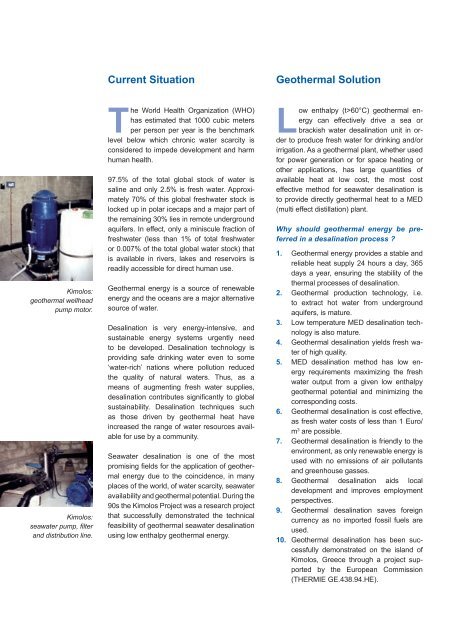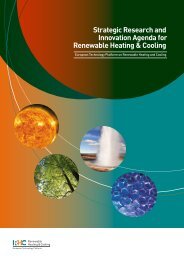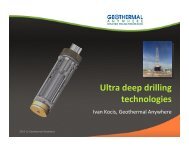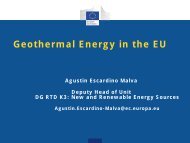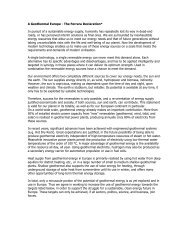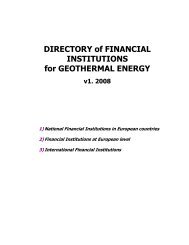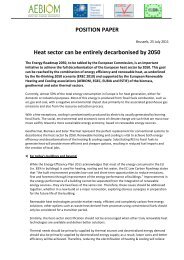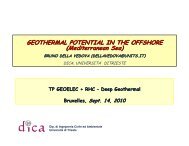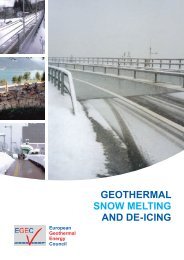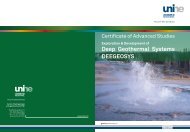GEOTHERMAL DESALINATION - EGEC
GEOTHERMAL DESALINATION - EGEC
GEOTHERMAL DESALINATION - EGEC
You also want an ePaper? Increase the reach of your titles
YUMPU automatically turns print PDFs into web optimized ePapers that Google loves.
Current Situation<br />
Geothermal Solution<br />
Kimolos:<br />
geothermal wellhead<br />
pump motor.<br />
Kimolos:<br />
seawater pump, filter<br />
and distribution line.<br />
The World Health Organization (WHO)<br />
has estimated that 1000 cubic meters<br />
per person per year is the benchmark<br />
level below which chronic water scarcity is<br />
considered to impede development and harm<br />
human health.<br />
97.5% of the total global stock of water is<br />
saline and only 2.5% is fresh water. Approximately<br />
70% of this global freshwater stock is<br />
locked up in polar icecaps and a major part of<br />
the remaining 30% lies in remote underground<br />
aquifers. In effect, only a miniscule fraction of<br />
freshwater (less than 1% of total freshwater<br />
or 0.007% of the total global water stock) that<br />
is available in rivers, lakes and reservoirs is<br />
readily accessible for direct human use.<br />
Geothermal energy is a source of renewable<br />
energy and the oceans are a major alternative<br />
source of water.<br />
Desalination is very energy-intensive, and<br />
sustainable energy systems urgently need<br />
to be developed. Desalination technology is<br />
providing safe drinking water even to some<br />
‘water-rich’ nations where pollution reduced<br />
the quality of natural waters. Thus, as a<br />
means of augmenting fresh water supplies,<br />
desalination contributes significantly to global<br />
sustainability. Desalination techniques such<br />
as those driven by geothermal heat have<br />
increased the range of water resources available<br />
for use by a community.<br />
Seawater desalination is one of the most<br />
promising fields for the application of geothermal<br />
energy due to the coincidence, in many<br />
places of the world, of water scarcity, seawater<br />
availability and geothermal potential. During the<br />
90s the Kimolos Project was a research project<br />
that successfully demonstrated the technical<br />
feasibility of geothermal seawater desalination<br />
using low enthalpy geothermal energy.<br />
Low enthalpy (t>60°C) geothermal energy<br />
can effectively drive a sea or<br />
brackish water desalination unit in order<br />
to produce fresh water for drinking and/or<br />
irrigation. As a geothermal plant, whether used<br />
for power generation or for space heating or<br />
other applications, has large quantities of<br />
available heat at low cost, the most cost<br />
effective method for seawater desalination is<br />
to provide directly geothermal heat to a MED<br />
(multi effect distillation) plant.<br />
Why should geothermal energy be preferred<br />
in a desalination process ?<br />
1. Geothermal energy provides a stable and<br />
reliable heat supply 24 hours a day, 365<br />
days a year, ensuring the stability of the<br />
thermal processes of desalination.<br />
2. Geothermal production technology, i.e.<br />
to extract hot water from underground<br />
aquifers, is mature.<br />
3. Low temperature MED desalination technology<br />
is also mature.<br />
4. Geothermal desalination yields fresh water<br />
of high quality.<br />
5. MED desalination method has low energy<br />
requirements maximizing the fresh<br />
water output from a given low enthalpy<br />
geothermal potential and minimizing the<br />
corresponding costs.<br />
6. Geothermal desalination is cost effective,<br />
as fresh water costs of less than 1 Euro/<br />
m 3 are possible.<br />
7. Geothermal desalination is friendly to the<br />
environment, as only renewable energy is<br />
used with no emissions of air pollutants<br />
and greenhouse gasses.<br />
8. Geothermal desalination aids local<br />
development and improves employment<br />
perspectives.<br />
9. Geothermal desalination saves foreign<br />
currency as no imported fossil fuels are<br />
used.<br />
10. Geothermal desalination has been successfully<br />
demonstrated on the island of<br />
Kimolos, Greece through a project supported<br />
by the European Commission<br />
(THERMIE GE.438.94.HE).


